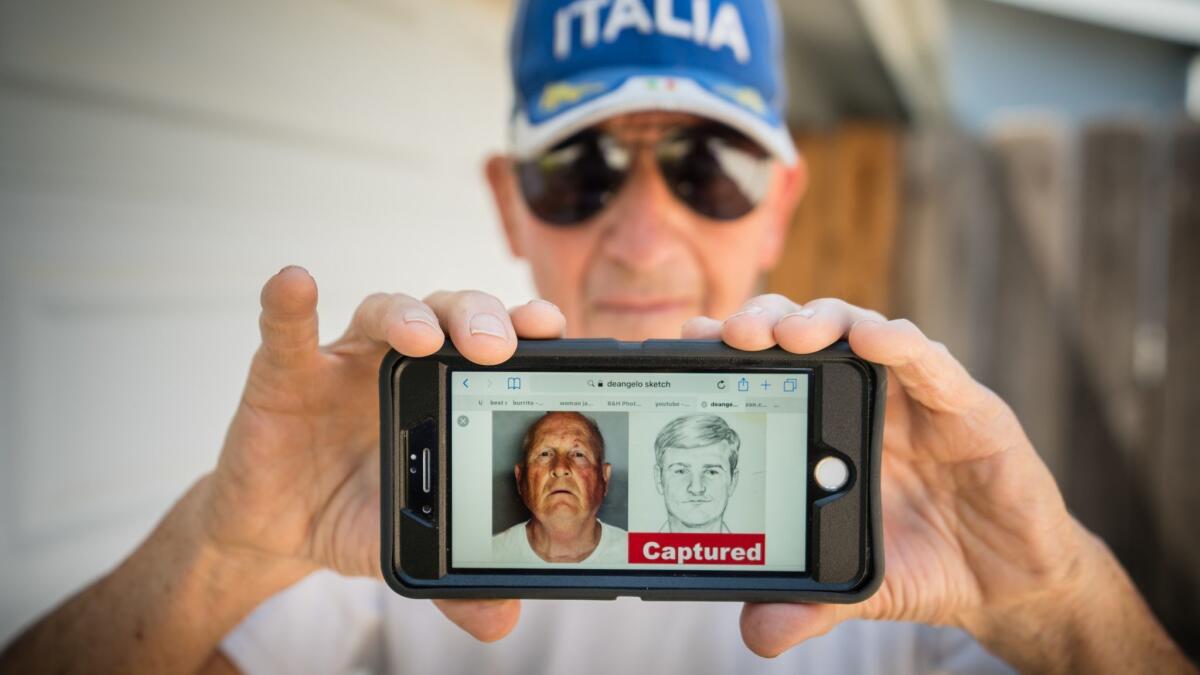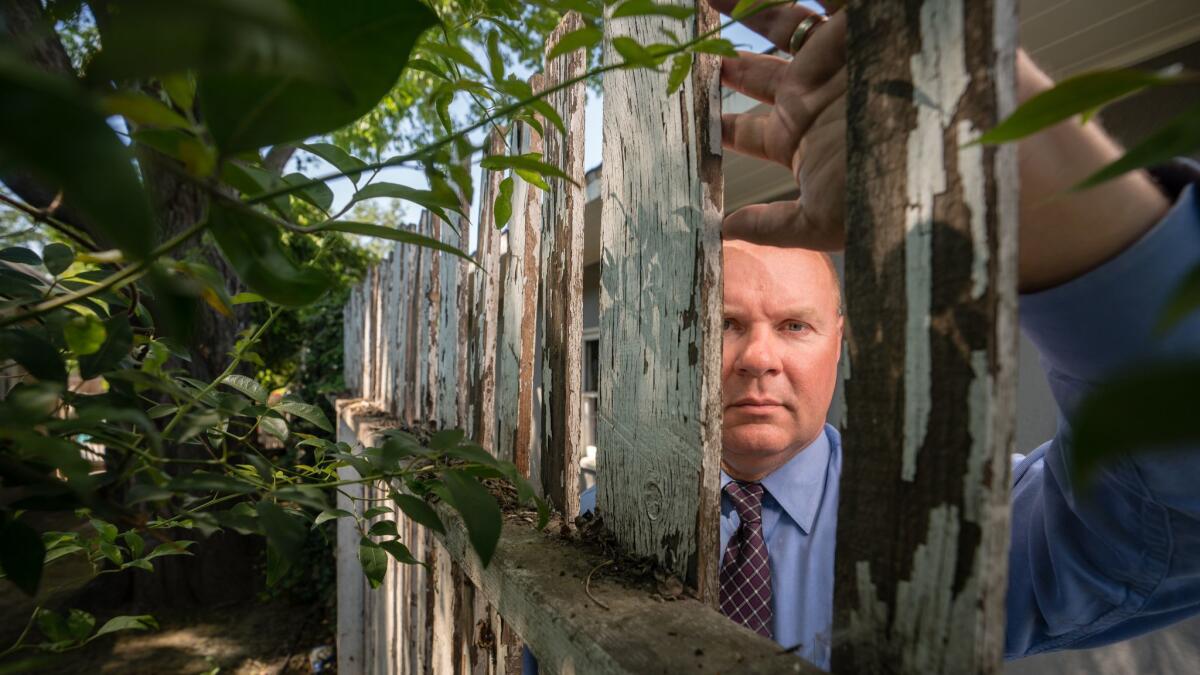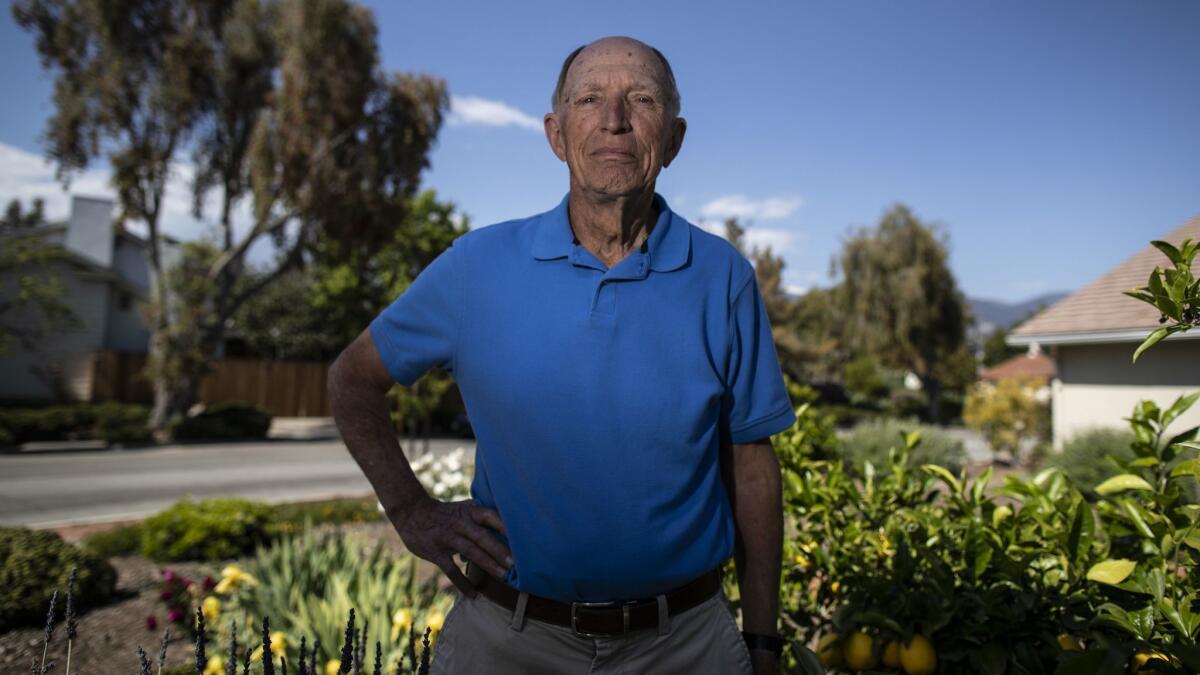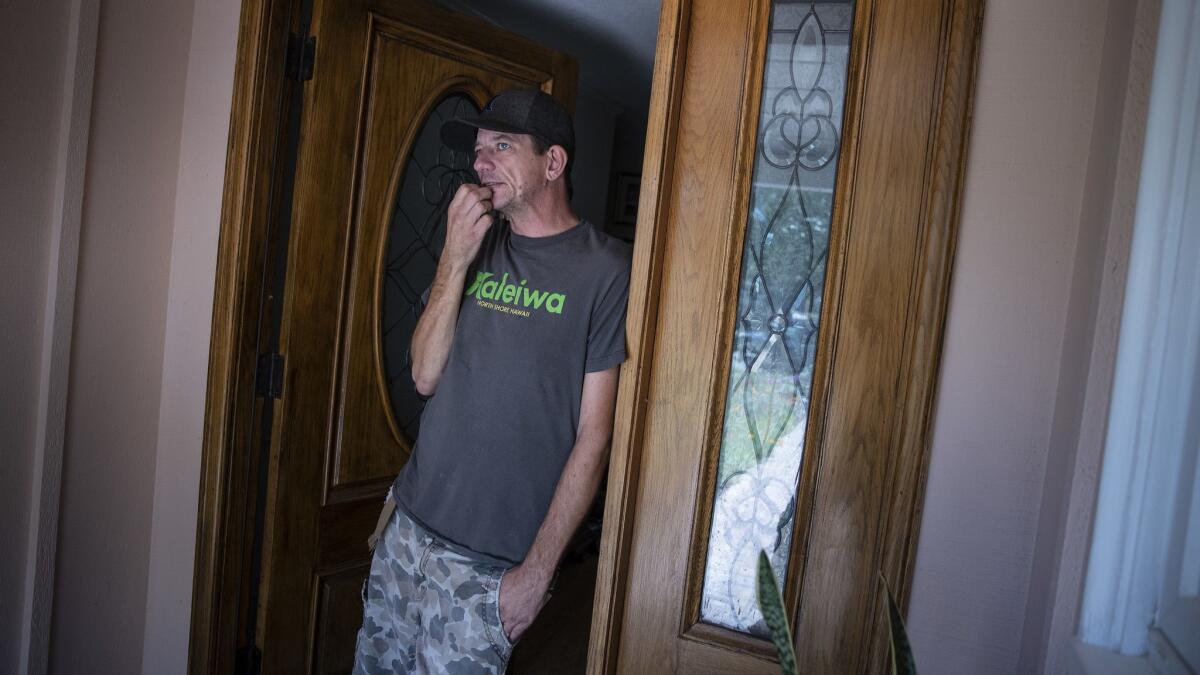Must Reads: In the Golden State Killer’s path, terror still runs deep

- Share via
In the 1970s, families moved to Sacramento’s expanding suburbs with fresh streets and open space so their children could play and wander at will.
Kids whiled away summer days riding dirt bikes through empty lots and pear orchards and played deep into the night on rowdy cul-de-sacs.
That sense of safety was shattered when a rapist began attacking women and teenage girls in 1976, causing panic throughout the region.
But when the same man came to a quiet beach community in Orange County four years later, bludgeoning a couple to death, few outside the neighborhood even heard about it. On the block where the killing took place, horrified reactions quickly gave way to vague rumors that a drug deal had gone awry — making neighbors feel they wouldn’t be targets.
The Golden State Killer’s rampage — at least 12 slayings and 46 rapes between 1974 and 1986 — wrought terror in some places, and barely registered in others.
He obliterated suburban tranquility in the Visalia and Sacramento areas. But his rapes and slayings in Southern California seemed unconnected, not the work of one man, but separate killers who likely knew the victims.
In the nearly two weeks since authorities arrested Joseph James DeAngelo Jr., 72, and charged him with eight of the murders, residents in the communities attacked by the Golden State Killer are either reliving a nightmare or realizing how close they escaped one.
Visalia
Authorities say his crimes started in Visalia in 1974.
When Terry Ommen moved there from Los Angeles two years before to join the police department, only 32,000 people lived in the farm town along Highway 198, which they could walk across.
“A lot of people viewed Visalia as a sleepy little town where nothing terribly bad happens,” he said. “So why bother locking doors or closing windows?”
Joe DeAngelo, a Vietnam veteran and Cal State Sacramento graduate, took a job nearby as an officer in the police department in Exeter, a small town off the highway passing travelers take to the giant sequoias.
The first suspected crimes of the serial rapist and killer began in April, when a man slinked through Visalia’s streets and alleys at night, burglarizing homes. He tore up drawers and drapery and furniture, earning the name The Visalia Ransacker.
Pat Monno returned from a visit to his sister’s house in Fresno to find his house trashed. “Every kitchen drawer, everything, dumped on the floor,” said Monno, now 83. He walked into his bedroom and saw that someone had taken every pair of his underwear and placed them down the hallway and into the family room “like stepping stones.”
The thief scattered his wife’s jewelry but didn’t take any of it, not even the diamond earrings. He took an Eisenhower coin, some framed photos, shotgun shells and a pistol.

One night after the burglary, the ransacker called Monno’s home. His wife answered and let out a scream.
Monno picked up the receiver and demanded: “Who is this?”
“I’m going to tell you the same thing I told your wife,” the ransacker said in a soft, slow voice. “I’m going to kill her, I’m going to kill you, and I’m going to kill your daughter.”
Monno replied: “You made one mistake: You left my shotgun. So you can try, but I’ll be waiting for you.”
The thief didn’t return. A few weeks after the burglary, Claude Snelling, a journalism professor at the College of the Sequoias, awoke to a sound outside. He stepped into his backyard and confronted a masked man who was kidnapping his teenage daughter.
The suspect pulled out a handgun — Monno’s stolen revolver — and shot Snelling to death and ran off without the girl. The killing terrified a town already unnerved by nearly 100 burglaries.
People started changing their behavior — they didn’t trust neighbors as much, and started locking doors and windows. “It was sort of like everyone was a little bit suspicious of everyone,” said Ommen, the police officer. He recalled making a minor arrest that drew the attention of passersby, who asked if it was “the ransacker.”
Clint Walker heard the gunshots that killed Snelling, and still lives in the house across the street. He watched sadly as the victim’s widow — like many others — installed outdoor flood lights for safety.
“She had the place lit up like a casino,” he said.
He was deeply affected by the shooting, he said, and has worried about crime ever since. He bought a handgun and got a concealed carry permit. “It’s sad. I don’t like it,” he said. “This is a last resort.”
By December 1975, the burglaries in Visalia stopped.
Sacramento
DeAngelo moved north to take a job with the Auburn Police Department outside of Sacramento in early 1976.
In nearby Rancho Cordova, Steve Stagnaro, 12, roamed freely, earning cash picking pears and alfalfa, meandering to school along an irrigation ditch with his friends, stopping to catch polliwogs.
That summer, Stagnaro read the scary headlines — rapes all within a few blocks of his house — as he stuffed newspapers in his bag for his paper route.
There was an attack on Benny Way, where he had a crush on a girl, then one on La Gloria Way, where he had another crush. He and his friends tried to find the rapist, super-hero-style, comparing faces of people they encountered to the police sketch. “It seemed like everybody looked like that,” recalled Stagnaro, now 54. “It was all we talked about all the time.”
At home, he felt safe with his father’s hunting weapons and the family dog, a Great Dane and St. Bernard mix.
But his mother did not. Ann Sandner began double-checking that the doors and windows were locked, and wedged a board in sliding glass doors so they couldn’t open from the outside.They didn’t have air conditioning, but they slept with the windows closed, trapping the broiling summer day heat.
“I can remember being scared for our kids and ourselves,” said Sandner, now 80.
The sadistic details of the attacks only sharpened the fear. Couples would wake up to a flashlight in their faces and the intruder would bind them up with shoe laces or curtain cords. He would rape the woman, scour the house for jewelry or rare coins, eat from the refrigerator, rape again. Sometimes he lingered for hours, toying with his victims. Tied up in the dark, they couldn’t see him, and were never sure when he was gone. Weeks later, the rapist would sometimes call to taunt the women and threaten to visit again.
The terror stayed with Sandner for nearly a decade.
O.M. Wichmann, who lives down the street from where the first rape occurred, was often home alone in the late ’70s — her three grown sons out of the house and her husband on the road for work.
Her colleague at the carpet store where she worked was terrified on her behalf, offering to come stay with her. Her husband soon installed an alarm system, bought a handgun and stopped going out of town for his job as a mobile home repairman.
Familiar faces became suspicious, she said.
“You looked at your neighbor and think: ‘I wonder where you were last night,’” recalled Wichmann, now 87.
One evening in February 1978, Ann Miller-Wilson, 10, and her siblings heard what they thought were firecrackers. When detectives came by the next day asking what they may have seen, they learned they were gunshots.
A couple walking their dog was shot to death in a backyard across the street. Investigators thought they interrupted the rapist trying to break into a home. Miller-Wilson and her siblings were shocked.
She and her brothers and sisters crept up to the driveway where the shooting happened and saw blood that had seeped out under a gate.
Miller-Wilson, now 51, said the killings colored her childhood. She was no longer allowed to play outside after dark, and banned from going to a nearby park. Her mother taught the girls to walk to their cars with keys in hand, something she has also drilled into her own daughters.
In recent years, she said, she grew intensely interested in the unsolved cases and devoured books and online forums about the killer.
“I always thought, is it somebody we all know?” she said. “I thought he was going to go down like Jack the Ripper and we’ll never know, only guess.”
The crimes shifted southwest, hitting sleepy bedroom communities up and down Interstate 680 in the East Bay: Walnut Creek, Concord, San Ramon and Danville.
They stopped in Northern California in July 1979, around the time DeAngelo was caught stealing a can of dog repellent and a hammer from a Pay ’N Save store in Citrus Heights. He was convicted of a misdemeanor for the theft in August and dismissed from the Auburn police force.
The slayings began in Southern California that December: a couple killed at their home near Goleta, another couple in Ventura in March.
Police saw no connections between the two sets of killings, nor any link to the attacks up north.
Dana Point
In August 1980, the stalker showed up farther south, at a gated neighborhood just outside Dana Point. Keith Harrington had recently moved into his father’s beach house on Cockleshell Drive with his new wife, Patricia, while he finished his studies at UCI Medical School. They were putting in a sprinkler system.
The killer slipped into the Harringtons’ house on Aug. 19, bound the couple with a macrame-type rope, raped Patricia and beat them to death with a brass sprinkler head he had found in the yard.
Keith’s father found their bodies two days later.
One resident on the street, who would speak only if her identity were not revealed, said she reported that her own house had been ransacked a week or so before the killing, and the culprit had dropped rare coins stolen from another neighbor. She also said her dog scared off a man trying to break in a few nights before the Harrington murders.
Orange County sheriff’s investigators have said the killer cased neighborhoods for days before he attacked.
Carole Daly, who lived on the next block with her two sons, remembers her oldest boy, then 15, coming home from surfing. “Mr. Harrington is sitting on the curb crying and the police are all around,” she recalled him saying.
She panicked when she heard the couple had been killed; she locked doors and put blankets on the windows. “We were afraid,” she said. “We didn’t know what happened.”
The Harrington house became known as “the murder house.”
The fear gave way to false rumors: Neighbors speculated it was a Mafia-style killing, or that the couple used drugs and were therefore connected to some underworld.
“There was a lot of suspicion about who did it,” said John Lee, now 46.
The father, Roger Harrington, used to let Lee, a toddler obsessed with tools, play in his garage. He set up a board with nails for the boy to hammer.
“They were nice people,” Lee said.
A few years after the killing, Lee’s friend Jake moved into “the murder house.” They built a skateboarding half-pipe in the backyard and mostly forgot about the deaths.
Irvine
The killer came back to south Orange County at least twice, striking next in Irvine, where residents there were just as baffled as those in Dana Point.
Bob Cart, 73, and his wife had moved into their one-story house in 1979 in the Northwood subdivision.
Like so many others in the master-planned community, they were a young family, with an infant daughter.
The neighborhood was freshly carved out of the orange groves.
In February 1981, Cart came home from work at the Laguna Hills Mall and his wife told him a woman — Manuela Witthuhn, 28, he would learn later — had been killed in her house nearby.
Irvine police said Witthuhn was raped and beaten and that the crime did not appear to be related to others in the area.
Cart’s wife was spooked. She bought Mace. They put dowel rods in all their windows, knowing the killer had come in through a sliding glass door. Every time Cart left town, she had her parents make the 9-hour drive from Lake County to stay with her and her daughter.
Eventually, the fear faded. They took false comfort in believing that the killer had specifically targeted Witthuhn.
“We’d been here a couple of years, and we knew it was a good place,” Cart said. “We kind of bought the story that somebody followed her from outside the area, that that’s how the bad guy got here.”
Other people, including friends of the victim, thought the killer was closer to home: The husband, David Witthuhn, was long haunted by the suspicion from the police and his wife’s family that he had killed her. DNA vindicated him after nearly two decades under a cloud; he died in 2008.

Goleta
The killer next doubled back to Santa Barbara County in July 1981, attacking a couple just north of Goleta this time, on Toltec Way, beating and shooting them both to death.
Adrian Peyrat, 82, a retired teacher, said he was home and awake when he heard what he thought was a gunshot. He remembered standing in his bathtub, peering out a small window, but he couldn’t see anything. The next morning detectives knocked on the door.
Peyrat said people began locking their doors and created a neighborhood watch.
Eric Wilke, 49, who lived just a few houses away, said his parents made him come in after dark. The cul-de-sac, usually bustling with kids, was empty by nightfall.
As in Dana Point, residents explained away the deaths, assuming they had resulted from a drug deal. The house never lost its stigma.
“It’s always going to be known as ‘the murder house,’” he said.

Aftermath
The seemingly uncatchable slayer struck one more time, again in the Northwood subdivision of Irvine on May 4, 1986, raping and killing 18-year-old Janelle Cruz.
It wasn’t until 2000 that detectives connected 12 of the unsolved deaths and realized they were the work of a serial killer, news that was barely noticed in Southern California. No one had any clue who the suspect was.
But a bestselling book about the rapes and slayings published in February — and then DeAngelo’s arrest on April 24 — dislodged memories in every neighborhood the killer hit.
For Carole Daly in Dana Point, it spooked her to know a serial killer had stalked the neighborhood her boys roamed.
The news dredged up another incident she had forgotten: In the years after the murders, she got a call from a man who said he was going to kill her. When she read recently that a lead investigator on the Sacramento area rapes shares her name, though spelled Carol Daly, she had to wonder if that threatening voice was the killer’s.
For Miller-Wilson, who heard the gunshots that killed her neighbors when she was a young girl in Rancho Cordova, confused emotion boiled up. She mapped out how close the suspect lived from her home: 3.3 miles.
With her daughter, she drove to DeAngelo’s house three times — out of a mix of curiosity and sadness. She was stricken by how normal and boring his house looked.
“A monster lived there,” she said, “just walking amongst us.”
This story was reported by Victoria Kim, Sarah Parvini, Hailey Branson-Potts, Ruben Vives and Joe Mozingo. It was written by Mozingo.
[email protected] | Twitter: @vicjkim
[email protected] | Twitter: @sarahparvini
[email protected] | Twitter: @haileybranson
[email protected] | Twitter: @LATvives
[email protected] | Twitter: @joemozingo
More to Read
Sign up for Essential California
The most important California stories and recommendations in your inbox every morning.
You may occasionally receive promotional content from the Los Angeles Times.















